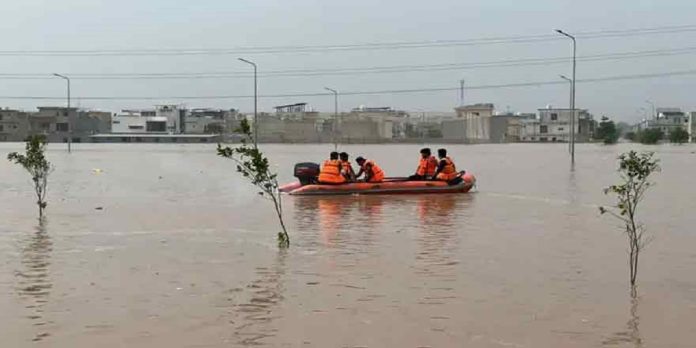ISLAMABAD: Almost four million people have been affected and 1.8 million displaced in Punjab province as rivers swelled to dangerous levels this week, officials said on Thursday.
Worsening Floodwaters are threatening the southern Punjab city of Multan and food security across the country.
Punjab most populous and agriculturally rich province, has seen thousands of villages inundated as the Chenab, Ravi and Sutlej rivers have overflown following days of heavy monsoon rains and upstream dam releases (Water Terrorism) from India.
Nationwide, rains, floods and landslides have killed more than 883 people since late June, reviving memories of Pakistan’s catastrophic 2022 deluges when a third of the country was submerged, 30 million displaced and losses topped $35 billion.
Punjab Relief Commissioner Nabeel Javed said in the statement on Thursday the floods had already claimed 46 lives in the latest spell of monsoon rains that began late last month and destroyed vast tracts of farmland in the country’s breadbasket province.
“Due to the severe flooding, more than 3,900 villages have been affected and 3.875 million people impacted,” Javed said in a statement.
“Around 1.8 million people have been relocated to safer places, 410 relief camps have been established, along with 444 medical and 395 veterinary camps”, he further added.
According to official figures, the Chenab river was flowing at 217,000 cusecs at Marala, 450,000 at Khanki and 507,000 at Qadirabad on Thursday afternoon, all showing a falling trend.
But at Chiniot bridge flows had climbed past 509,000 cusecs and were still rising, while gauges at Trimmu, Head Muhammad Wala and Sher Shah remained close to their danger marks.
On the Ravi, levels were recorded at 84,000 cusecs at Jassar and nearly 128,000 at Balloki, both rising, while flows of 101,000 at Ravi Syphon and 99,700 at Shahdara were steady. Sidhnai headworks stood at 139,000 cusecs, also steady for now.
The Sutlej was carrying heavy inflows of 335,000 cusecs at Ganda Singh Wala, steady but elevated, with 139,500 at Sulemanki on the rise. Flows stood at 95,700 at Islam headworks and 169,000 at Panjnad, both steady, while Malsi Syphon reported 90,700 cusecs.
The mixed trends on the Chenab — falling upstream but still rising downstream at Chiniot and holding high at Trimmu and Head Muhammad Wala — have kept the city of Multan under imminent threat.
Punjab Disaster Management Authority chief Irfan Ali Kathia said the next 24 hours were “extremely critical” for Multan as the Chenab surge moved toward the city and merged with high flows from the Ravi.
“This is a critical time for the city and district of Multan,” he told media, adding, the main surge of the Chenab has already reached Head Muhammad Wala at its peak and is now moving downstream.
With about 2.6 million resident, Multan, though smaller in population than Lahore or Karachi, is the economic hub of southern Punjab, known for its fertile farmland, mango exports and textile industry, making any disruption there significant for the wider economy.
Reservoirs in both Pakistan and India were near capacity, with Tarbela Dam reported at 100 percent and Mangla at 87 percent, while India’s Bhakra, Pong and Thein dams were all above 90 percent, officials said.
With reservoirs brimming on both sides of the border and flood peaks still moving downstream, authorities warn that the southern Sindh province would face the combined impact of Punjab’s swollen rivers within days.
Read more: India Issue Sutlej Flood Warning To Pakistan Amid Punjab’s Swelling Rivers


